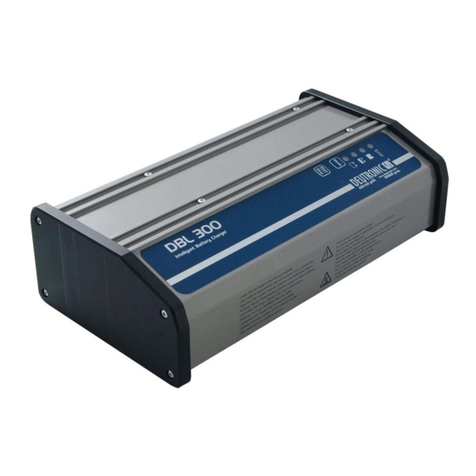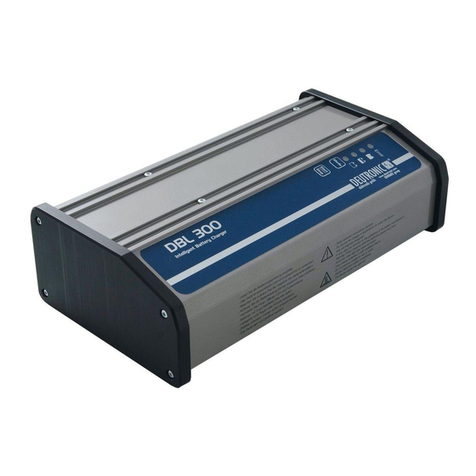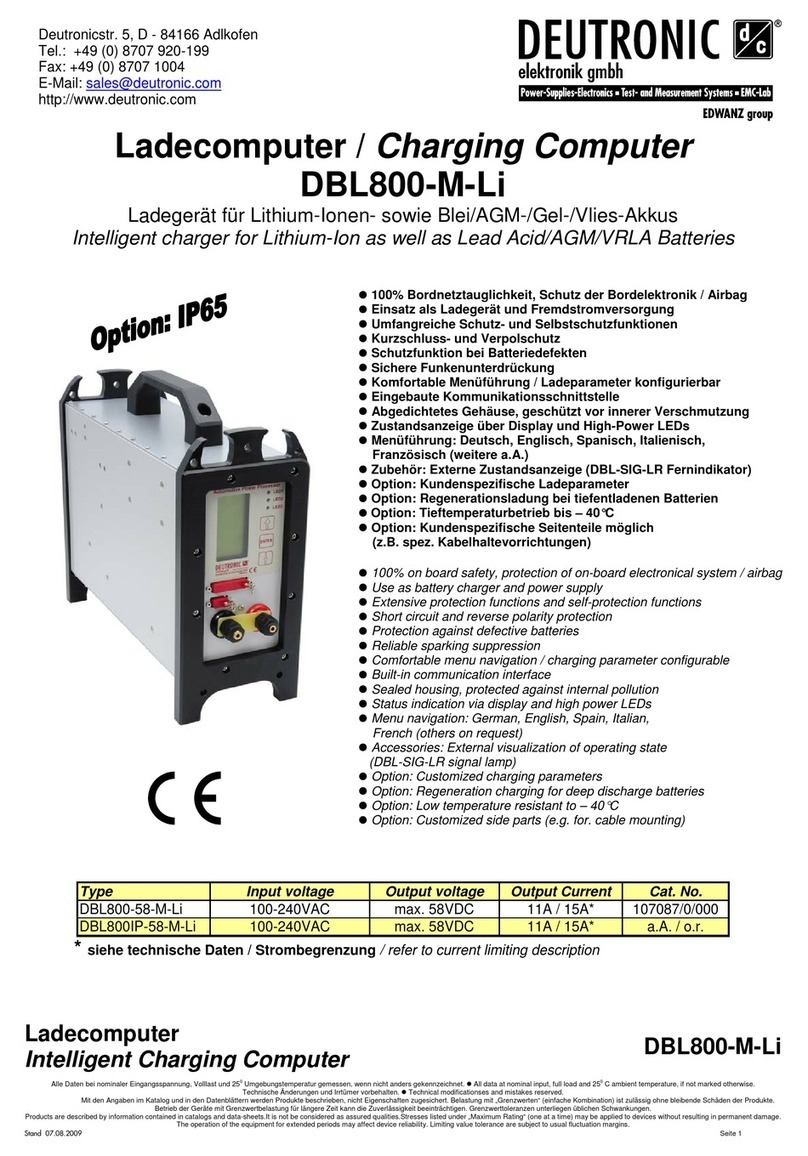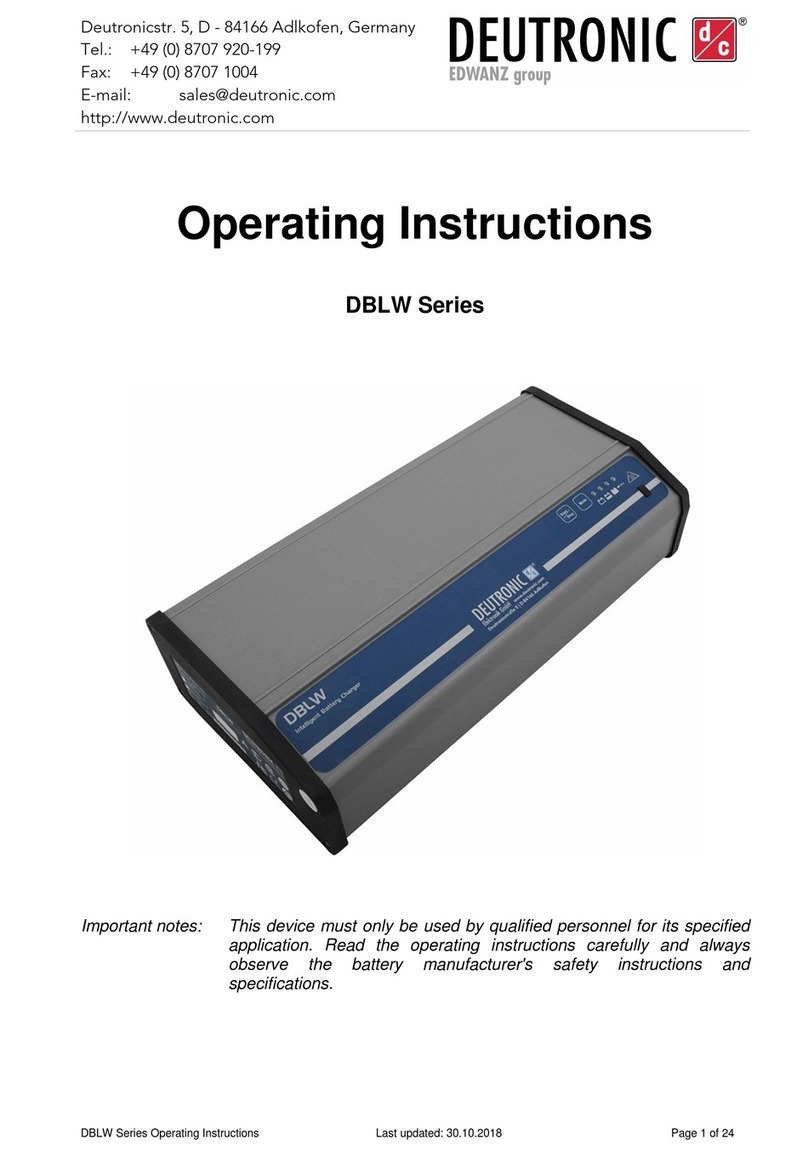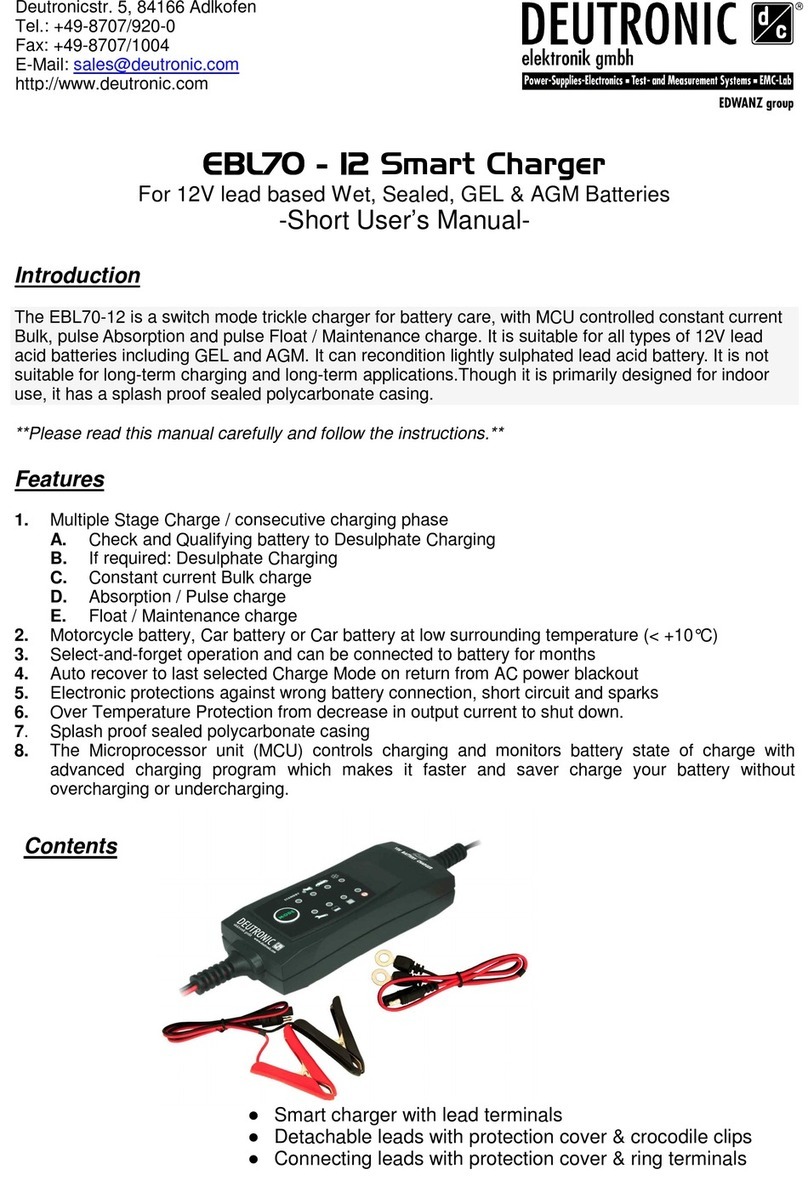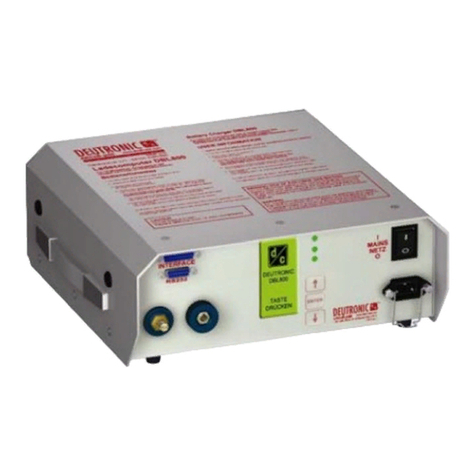Deutronic DBL 75-14 User manual

Smart Charger
DBL75 - 14
All data at nominal input, full load and 250 C ambient temperature, if not marked otherwise.
Technical modifications and mistakes reserved.
Products are described by information contained in catalo s and data-sheets.It is not be considered as assured qualities.Stresses listed under „Maximum Ratin “ (one at a time) may be applied to devices without resultin in permanent
dama e. The operation of the equipment for extended periods may affect device reliability. Limitin value tolerance are subject to usual fluctuation mar ins.
State 29.09.2017
Pa e 1 of 14
170901_DBL75_manual_EN.doc
Deutronicstraße 5, 84166 Adlkofen / Germany
Tel.: +49 (0) 8707 920-199
Fax: +49 (0) 8707 1004
E-Mail: [email protected]om
http://www.deutronic.com
DBL75 – 14 Smart Charger
For 12V LiFePO4- and all types of 12V lead-acid batteries
-Operating Instructions-
The DBL 75-14 is a microprocessor controlled trickle charger for battery care of automotive batteries.
Equipped with an intelligent, adaptive charging- and regeneration process and automatic battery
chemistry detection. It is suitable for all types of 12V lead-acid batteries including GEL and AGM, also
for 12V LiFePO4 batteries. It is able to recognition lightly sulphated lead-acid batteries. The battery
charger automatically detects type of battery and automatically selects an ideal charging process.
**Please read this manual carefully and follow the instructions**

Smart Charger
DBL75 - 14
All data at nominal input, full load and 250 C ambient temperature, if not marked otherwise.
Technical modifications and mistakes reserved.
Products are described by information contained in catalo s and data-sheets.It is not be considered as assured qualities.Stresses listed under „Maximum Ratin “ (one at a time) may be applied to devices without resultin in permanent
dama e. The operation of the equipment for extended periods may affect device reliability. Limitin value tolerance are subject to usual fluctuation mar ins.
State 29.09.2017
Pa e 2 of 14
170901_DBL75_manual_EN.doc
Deutronicstraße 5, 84166 Adlkofen / Germany
Tel.: +49 (0) 8707 920-199
Fax: +49 (0) 8707 1004
E-Mail: [email protected]om
http://www.deutronic.com
Important Safety Instructions
-
This charger is designed for only maintain above-named battery types.
-
For indoor use only.
-
Explosion hazard: A battery being charged could emit explosive gases. Therefore avoid smoking or open sparks
or naked flames in the vicinity of the battery.
-
Does not cover the charger while charging; allow good ventilation to the charger.
-
Danger of chemical burns: battery acid is highly corrosive.
-
If your skin or eyes come into contact with acid, immediately rinse the affected part with excessive water and seek
medical attention.
-
Do not charge a frozen battery.
-
Do not charge a damaged battery.
-
Disconnect battery from charger which is not connected to AC mains socket.
-
Do not recharge non-rechargeable batteries
-
If the cord is damaged, the trickle charger should be scrapped.
-
For safety reasons, it is recommended to check the charging operation from time to time, when it is intended to
keep the charger connected for longer period of time.
-
This appliance can be used by children aged from 8 years and above and persons with reduced physical, sensory
or mental capabilities or lack of experience and knowledge if they have been given supervision or instruction
concerning use of the appliance in a safe way and understand the hazards involved. Children shall not play with
the appliance. Cleaning and user maintenance shall not be made by children without supervision.
When charging mounted automotive battery:
-
The battery terminal not connected to the chassis has to be connected first. The other connection is to be made
to the chassis, remote from the battery and fuel line. The battery charger is then to be connected to the supply
mains.
-
After charging, disconnect the charger from the supply mains. Then remove the chassis connection first followed
by the battery connection.
-
Low temperature LED is only glowing, when charger detects need for adjusted charging process.
Attention: For safety reasons regeneration procedure has to be done under surveillance!

Smart Charger
DBL75 - 14
All data at nominal input, full load and 250 C ambient temperature, if not marked otherwise.
Technical modifications and mistakes reserved.
Products are described by information contained in catalo s and data-sheets.It is not be considered as assured qualities.Stresses listed under „Maximum Ratin “ (one at a time) may be applied to devices without resultin in permanent
dama e. The operation of the equipment for extended periods may affect device reliability. Limitin value tolerance are subject to usual fluctuation mar ins.
State 29.09.2017
Pa e 3 of 14
170901_DBL75_manual_EN.doc
Deutronicstraße 5, 84166 Adlkofen / Germany
Tel.: +49 (0) 8707 920-199
Fax: +49 (0) 8707 1004
E-Mail: [email protected]om
http://www.deutronic.com
Safety Instructions:
1. Save these instructions.
This manual contains important safety and operating instructions.
2. Do not expose charger to rain or snow.
3. Use of an attachment not recommended or sold by the battery charger manufacturer may result in a risk of fire,
electric shock, or injury to persons.
4. To reduce risk of damage to electric plug and cord, pull by plug rather than cord when disconnecting charger.
5. An extension cord should not be used unless absolutely necessary. Use of improper extension cord may result in
a risk of fire and electric shock. If extension cord must be used, make sure:
a) That pins on plug of extension cord are the same number, size, and shape as those of plug on charger.
b) That extension cord is properly wired and in good electrical condition.
c) That wire size is large enough for AC ampere rating of charger.
6. Do not operate charger with damaged cord or plug – replace the cord or plug immediately.
7. Do not operate charger if it has received a sharp blow, been dropped, or otherwise damaged in any way; take it to
a qualified serviceman or service center.
8. Do not disassemble charger; take it to a qualified serviceman or service center when service or repair is required.
Incorrect reassembly may result in a risk of electric shock or fire.
9. To reduce risk of electric shock, unplug charger from outlet before attempting any maintenance or clearing.
Turning off controls will not reduce this risk.
10. WARNING – Risk of explosive gases:
a) Working in the vicinity of a lead-acid battery is dangerous: Batteries generate explosive gases during normal
battery operation: For this reason, it is of utmost importance that each time before using your charger you read
this manual and follow the instructions exactly.
b) Reduce risk of battery explosion; follow these instructions and those published by battery manufacturer and
manufacturer of any equipment you intend to use in vicinity of battery. Review cautionary marking on these
products and on engine.
11. Personal Precautions
a) Someone should be within range of your voice or close enough to come to your aid when you work near a lead-
acid battery.
b) Have plenty of fresh water and soap nearby in case battery acid contacts skin, clothing, or eyes.
c) Wear complete eye protection and clothing protection. Avoid touching eyes while working near battery.
d) If battery acid contacts skin or clothing, wash immediately with soap and water. If acid enters eye, immediately
flood eye with running cold water for at least 10 minutes and get medical attention immediately.
e) Be extra cautious to reduce risk of dropping a metal tool onto battery. It might spark or short-circuit battery or
other electrical part that may cause explosion.
f) Remove personal metal items such as rings, bracelets, necklaces, and watches when working with lead-acid
battery. A lead-acid battery can produce a short-circuit current high enough to weld a ring or similar metal items,
causing a severe burn.

Smart Charger
DBL75 - 14
All data at nominal input, full load and 250 C ambient temperature, if not marked otherwise.
Technical modifications and mistakes reserved.
Products are described by information contained in catalo s and data-sheets.It is not be considered as assured qualities.Stresses listed under „Maximum Ratin “ (one at a time) may be applied to devices without resultin in permanent
dama e. The operation of the equipment for extended periods may affect device reliability. Limitin value tolerance are subject to usual fluctuation mar ins.
State 29.09.2017
Pa e 4 of 14
170901_DBL75_manual_EN.doc
Deutronicstraße 5, 84166 Adlkofen / Germany
Tel.: +49 (0) 8707 920-199
Fax: +49 (0) 8707 1004
E-Mail: [email protected]om
http://www.deutronic.com
g) Use charger for charging above-named battery types only. Do not use battery charger for charging dry-cell
batteries that are commonly used with home appliances. These batteries may burst and cause injury to persons
and damage to property.
h) NEVER charge a frozen battery
12. Preparing to charge
a) If it is necessary to remove battery from vehicle to charge, always remove grounded terminal from battery first.
Make sure all accessories in the vehicle are off, so as not to cause an arc.
b) Be sure area around battery is well ventilated while battery is being charged. Gas can be forcefully blown away by
using a piece of cardboard or other non-metallic material as a fan.
c) Clean battery terminals. Be careful to keep corrosion from coming in contact with eyes.
d) Add distilled water in each cell until battery acid reaches level specified by battery manufacturer. This helps purge
excessive gas from cell. Do not overfill. For a battery without cell-caps, carefully follow manufacturers recharging
instructions.
e) Study all battery manufacturer‘s specific precautions such as removing or not removing cell caps while charging
and recommended rates of charge.
f) Determine voltage of battery by referring to car owner‘s manual and make sure it matches output rating of battery
charger.
13. Charger location
a) Locate charger as far away from battery as DC cables permit. Never place charger directly above battery being
charged. Gases from battery will corrode and damage charger.
b) Never allow battery acid to dip on charger when reading gravity or filling battery.
c) Do not operate charger in a closed-in area or restrict ventilation in any way.
d) Do net set a battery on top of charger.
14. DC connection precautions
a) Connect and disconnect dc output clips only after setting any charger switches to “off” position and removing ac
cord from electric outlet. Never allow clips to touch each other.
b) Attach clips to battery and chassis as indicated in 15(f), 15(g), 16(c), and 16(d).
15. Follow these steps when battery is installed in vehicle. A spark near battery may cause battery explosion: To
reduce risk of spark near battery:
a) Position ac and dc cords to reduce risk of damage by hood, door, or moving engine part.
b) Stay clear of fan blades, belts, pulleys, and other parts that can cause injury to persons.
c) Plug in the charger to AC mains.
d) Check polarity of battery posts POSITIVE (POS, P, +) battery post usually has larger diameter than NEGATIVE
(NEG, N, -) post.
e) Determine which post of battery is grounded (connected) to the chassis. If negative post is grounded to chassis
(as in most vehicles), see 15(f). If positive post is grounded to the chassis, see 15(g).
f) For negative-grounded vehicles, connect POSITIVE (RED) clip from battery charger to POSITIVE (POS, P, +)
ungrounded post of battery. Connect NEGATIVE (BLACK) clip from battery charger far from battery with chassis
or engine block. Do not connect clip to carburator, fuel lines, or sheet-metal body parts. Connect to a big and thick
chassis or engine block metal piece.
g) For positive-grounded vehicle, connect NEGATIVE (BLACK) clip from charger to NEGATIVE (NEG, N, -)
ungrounded post of battery. Connect POSITIVE (RED) clip from battery charger far from battery with chassis or
engine block. Do not connect clip to carburator, fuel lines, or sheet-metal body parts. Connect to a big and thick
chassis or engine block metal piece.
h) When disconnecting charger, plug off the charger to from AC mains and then remove clips from chassis and
battery terminal.

Smart Charger
DBL75 - 14
All data at nominal input, full load and 250 C ambient temperature, if not marked otherwise.
Technical modifications and mistakes reserved.
Products are described by information contained in catalo s and data-sheets.It is not be considered as assured qualities.Stresses listed under „Maximum Ratin “ (one at a time) may be applied to devices without resultin in permanent
dama e. The operation of the equipment for extended periods may affect device reliability. Limitin value tolerance are subject to usual fluctuation mar ins.
State 29.09.2017
Pa e 5 of 14
170901_DBL75_manual_EN.doc
Deutronicstraße 5, 84166 Adlkofen / Germany
Tel.: +49 (0) 8707 920-199
Fax: +49 (0) 8707 1004
E-Mail: [email protected]om
http://www.deutronic.com
16. Follow these steps when battery is outside vehicle. A spark near the battery may cause battery explosion. To
reduce risk of spark near battery:
a) Plug in the charger to AC mains.
b) Check polarity of battery posts. POSITIVE (POS, P, +) battery post usually has a larger diameter than NEGATIVE
(NEG, N, -) post.
c) Attach at least a 24-inch long (61cm) 6-guage (AWG) insulated battery cable to NEGATIVE (NEG, N, -) battery
post.
d) Connect POSITIVE (RED) charger clip to POSITIVE (POS, P, +) post of battery.
e) Position yourself as far away from the battery as possible and then connect NEGATIVE (BLACK) charger clip to
free end of battery cable.
f) When disconnecting charger, first plug off the charger from AC mains and then do go on in reverse sequence of
connecting procedure. Disconnect the first connection while positioned as far away from the battery as possible.
Table of contents
Other Deutronic Batteries Charger manuals
